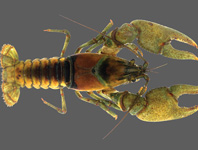Abstract
Two new species of freshwater crayfish are described from the Ozarks Plateau of northern Arkansas and southern Missouri. Both species are restricted to the mainstem of rocky streams that are at least fourth-order or greater in size. Recent genetic and morphological investigations of the coldwater crayfish, Faxonius eupunctus Williams, 1952, indicated that it was actually composed of several undescribed species. Faxonius eupunctus is herein restricted to just the Eleven Point River system. Faxonius roberti, new species is found in the mainstem of the Spring and Strawberry river systems in northern Arkansas. It differs from F. eupunctus by lacking a male Form-I gonopod with a distal spatulate mesial process, and presence of two spines on the dorsal side of the merus, where F. eupunctus typically has 1 spine. Faxonius wagneri, new species is known from a 54 mile (86 km) stretch of the Eleven Point River mainstem, ranging from just southeast of Greer, Missouri to just north of Birdell, Arkansas. Faxonius wagneri can be differentiated from both F. eupunctus and Faxonius roberti sp. nov. by using the male Form-I and Form-II gonopods, the shape of the chelae, and the female annulus ventralis. In F. wagneri, the terminal elements of the first pleopod are almost twice as long as those in F. eupunctus and F. roberti, with the tips of the appendage reaching the posterior base of the first perieopod when the abdomen is flexed forward, whereas, in the other two species, these elements only reach the base of the second pereiopod. The species also possesses two spines on the dorsal side of the merus of the first pereiopod, which helps distinguish it from F. eupunctus.
References
Crandall, K.A. & De Grave, S. (2017) An updated classification of the freshwater crayfishes (Decapoda: Astacidea) of the world, with a complete species list. Journal of Crustacean Biology, 37, 615–653.
https://doi.org/10.1093/jcbiol/rux070Darriba, D., Taboada, G.L., Doallo, R. & Posada, D. (2012) jModelTest 2: more models, new heuristics and parallel computing. Nature Methods, 9, 772–772.
https://doi.org/10.1038/nmeth.2109Fetzner Jr., J.W. & Crandall, K.A. (2003) Linear habitats and the nested clade analysis: an empirical evaluation of geographic versus river distances using an ozark crayfish (Decapoda: Cambaridae). Evolution, 57, 2101–2118.
https://doi.org/10.1111/j.0014-3820.2003.tb00388.xFetzner Jr., J.W., DiStefano, R.J. & Wagner, B.K. (2013) Assessing genetic variation and phylogeographic patterns among populations of the imperiled coldwater crayfish (Orconectes eupunctus) from the Eleven Point, Spring, and Strawberry river drainages of Missouri and Arkansas. Final Wildlife Diversity Funding Program Report submitted to the Missouri Department of Conservation, Columbia, Missouri, vi + 31 pp.
Fitzpatrick Jr., J.F. (1987) The subgenera of the crawfish genus Orconectes (Decapoda: Cambaridae). Proceedings of the Biological Society of Washington, 100 (1), 44–74.
Flinders, C.A. & Magoulick, D.D. (2005) Distribution, habitat use and life history of stream-dwelling crayfish in the Spring River drainage of Arkansas and Missouri with a focus on the imperiled Mammoth Spring crayfish (Orconectes marchandi). American Midland Naturalist, 154, 358–374.
https://doi.org/10.1674/0003-0031(2005)154[0358:DHUALH]2.0.CO;2Folmer, O., Black, M., Hoeh, W., Lutz, R. & Vrijenhoek, R. (1994) DNA primers for amplification of mitochondrial cytochrome c oxidase subunit I from diverse metazoan invertebrates. Molecular Marine Biology and Biotechnology, 3, 294–299.
Hobbs Jr., H.H. (1974) A checklist of the North and Middle American crayfishes (Decapoda: Astacidae and Cambaridae). Smithsonian Contributions to Zoology, 166, 1–161.
https://doi.org/10.5479/si.00810282.166Hobbs Jr., H.H. (1989) An illustrated checklist of the American crayfishes (Decapoda: Astacidae, Cambaridae, and Parastacidae). Smithsonian Contributions to Zoology, 480, 1–236.
https://doi.org/10.5479/si.00810282.480Imhoff, E.M., Moore, M.J. & DiStefano, R.J. (2012) Introduced alien ringed crayfish (Orconectes neglectus neglectus [Faxon 1885]) threaten imperiled coldwater crayfish (Orconectes eupunctus Williams 1952) in the Eleven Point River drainage, Missouri, USA. Aquatic Invasions, 7, 129–134.
https://doi.org/10.3391/ai.2012.7.1.014Johnson, D.P. (2010) Four new crayfishes (Decapoda: Cambaridae) of the genus Orconectes from Texas. Zootaxa, 2626, 1–45.
Larson, E.R. & Magoulick, B.B. (2008) Does juvenile competition explain displacement of a native crayfish by an introduced crayfish? Biological Invasions, 11 (3), 725–735.
https://doi.org/10.1007/s10530-008-9286-2Maddison, W.P. & Maddison, D.R. (2015) Mesquite: a modular system for evolutionary analysis. Version 3.04.
http://mesquiteproject.wikispaces.com/installation/. (accessed 6 November 2017)
McCune, B. & Grace, J.B. (2002) Analysis of Ecological Communities. MjM Software Design, Gleneden Beach, OR, 300 pp.
Oksanen, J., Blanchet, F.G., Friendly, M., Kindt, R., Legendre, P., McGlinn, D., Minchin, P.R., O'Hara, R.B., Simpson, G.L., Solymos, P., Stevens, M.H.H., Szoecs, E. & Wagner, H. (2016) Vegan: Community Ecology Package. R package version 2.4-1. Available from: https://CRAN.R-project.org/package=vegan. (accessed 6 November 2017)
Pflieger, W.L. (1996) The crayfishes of Missouri. Missouri Department of Conservation, Jefferson City, Missouri, 152 pp.
R Core Team (2017) R: A language and environment for statistical computing. R Foundation for Statistical Computing, Vienna, Austria. Available from: https://www.R-project.org/ (accessed 6 November 2017)
Revelle, W. (2016) Psych: Procedures for Personality and Psychological Research, Northwestern University, Evanston, Illinois, USA. Version 1.6.12. Available from: https://cran.r-project.org/web/packages/psych/index.html (accessed 6 November 2017)
Ronquist, F. & Huelsenbeck, J.P. (2003) MrBayes 3: Bayesian phylogenetic inference under mixed models. Bioinformatics, 19, 1572–1574.
https://doi.org/10.1093/bioinformatics/btg180Swofford, D.L. (2002) PAUP*. Phylogenetic Analysis Using Parsimony (*and Other Methods). Version 4. Sinauer Associates, Sunderland, Massachusetts. [software]
Taylor, C.A. & Knouft, J.H. (2006) Historical influences on genital morphology among sympatric species: gonopod evolution and reproductive isolation in the crayfish genus Orconectes (Cambaridae). Biological Journal of the Linnean Society, 89, 1–12.
https://doi.org/10.1111/j.1095-8312.2006.00637.xTaylor, C.A., Schuster, G.A., Cooper, J.E., DiStefano, R.J., Eversole, A.G., Hamr, P., Hobbs III, H.H., Robison, H.W., Skelton, C.E. & Thoma, R.F. (2007) A reassessment of the conservation status of crayfishes of the United States and Canada: the effects of 10+ years of increased awareness. Fisheries, 32, 372–389.
https://doi.org/10.1577/1548-8446(2007)32[372:AROTCS]2.0.CO;2Williams, A.B. (1952) Six new crayfishes of the genus Orconectes (Decapoda: Astacidae) from Arkansas, Missouri and Oklahoma. Transactions of the Kansas Academy of Science, 55, 330–351.
https://doi.org/10.2307/3626240Williams, A.B. (1954) Speciation and distribution of the crayfishes of the Ozark Plateaus and Ouachita Provinces. University of Kansas Science Bulletin, 36, 803–918.

